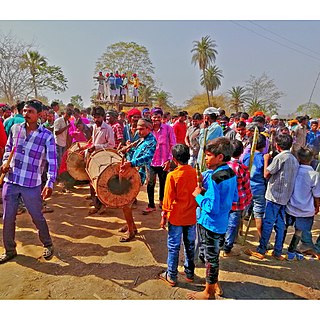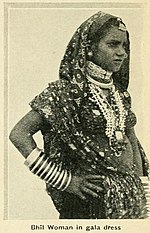
The Adivasi are heterogeneous tribal groups across the Indian subcontinent. The term is a Sanskrit word coined in the 1930s by political activists to give the tribal people an indigenous identity by claiming an indigenous origin. The term is also used for ethnic minorities, such as Chakmas of Bangladesh, Bhumiputara Khasas of Nepal, and Vedda of Sri Lanka. The Constitution of India does not use the word Adivasi, instead referring to Scheduled Tribes and Janjati. The government of India does not officially recognise tribes as indigenous people. The country ratified the International Labour Organization (ILO) Convention 107 on Indigenous and Tribal Peoples of the United Nations (1957) and refused to sign the ILO Convention 169. Most of these groups are included in the Scheduled Tribe category under constitutional provisions in India.

Bhili, IPA:[bʱiːliː], is an indigenous language spoken in west-central India, in the states of Rajasthan, Gujarat, Maharashtra, and Madhya Pradesh. Other names for the language include Bhagoria and Bhilboli; several varieties are called Garasia. Bhili is a member of the Bhil languages, which are related to Gujarati and Rajasthani. The language is written using the Devanagari script.

Nandurbar district is an administrative district in the northwest corner of Maharashtra state in India. On 1 July 1998 Dhule was bifurcated as two separate districts now known as Dhule and Nandurbar. Nandurbar is a tribal-dominated district, The district headquarters are located at Nandurbar city. The district occupies an area of 5,955 square kilometres (2,299 sq mi) and has a population of 1,648,295 of which 16.71% were urban.

The Bhil languages are a group of Indo-Aryan languages spoken by around 10.4 million Bhils in western and central India as of 2011. They constitute the primary languages of the southern Aravalli Range in Rajasthan and the western Satpura Range in Madhya Pradesh, northwestern Maharashtra, and southern Gujarat. According to the 52nd report of the commissioner for linguistic minorities in India, Ministry of Minority Affairs, Bhili is the most commonly spoken language of the district of Dadra and Nagar Haveli constituting 40.42% of its total population. Bhili speakers are also significant in the states of Gujarat (4.75%), Madhya Pradesh (4.93%) and Rajasthan (4.60%).
Parmar, also known as Panwar or Pawar, is a Rajput clan found in Northern and Central India, especially in Rajasthan, Gujarat, Punjab, Haryana, Uttarakhand, Uttar Pradesh, Bihar, Madhya Pradesh and North Maharashtra. The clan name is also used by Kōḷīs, Garoḍās, Līmaciyā Valands, Mōcīs, Tūrīs, Luhārs, Kansārās, Darajīs, Bhāvasārs, Cūnvāḷiyās, Ghañcīs, Harijans, Sōnīs, Sutārs, Dhobīs, Khavāsas, Rabārīs, Āhīrs, Sandhīs, Pīñjārās, Vāñjhās, Dhūḷadhōyās, Rāvaḷs, Vāgharīs, Bhīls, Āñjaṇās, Mer and Ḍhēḍhs.
PARDHI is a Hindu tribe in India. The tribe is found mostly in Maharashtra and parts of Madhya Pradesh however small numbers can be found in Gujarat and Andhra Pradesh. The word Pardhi is derived from the Marathi word ‘Paradh’ which means hunting and Sanskrit word ‘papardhi’ which means hunting or the game to be hunted. In some parts of India Pardhis are known as Meywarees. They also have various other names like Advichincher, Phans Pardhi, Phanse Pardhi, Langoli Pardhi, Bahelia, Bahellia, Chita Pardhi, Shikari, Takankar, Takia Pardhi. Pardhi tribe is divided in groups like Vaghri Pardhi and Phase Pardhi. These are further divided into subgroups like Pal Pardhi, Gav Pardhi, Takankar, Takari. Widely found surnames among them include Chauhan (Chavan), Rathod and Solanki.

Dahod district is a district of Gujarat state in western India. This largely tribal district is mostly covered by forests and hills.

Jhabua is a district of Madhya Pradesh state in central India. The town of Jhabua is the administrative headquarters of the district.

Banswara District has an area of 5,037 km2 (1,945 sq mi), which is 1.47% of Rajasthan state, India. The city of Banswara is the district headquarters. It is bounded on the north by Udaipur District, on the northeast by Pratapgarh District, on the east and southeast by Madhya Pradesh state, on the southwest by Gujarat state, and on the west by Dungarpur District.
Rampura is a town and Nagar palika, near Neemuch town in the Neemuch district of the Indian state of Madhya Pradesh. Rampura was founded by Rama bhil. Mahagarh was also ruled by Bhil king ,Rama was King but after the defeat against Chandrawats of Mewar, the town of Rampura was under their control until the independence of India.
The Dhanka are a tribe or caste of India who believe themselves to be aboriginal, although they are unable to assert from whence they came. They are found in Rajasthan, Haryana, Uttar Pradesh,Gujarat, Maharashtra, Chhattisgarh and Madhya Pradesh they are no relation with dhanuk kurmi. They are historically neither Hindu nor Muslim and their occupations have changed over time, as circumstances have dictated for survival. Although similar groups in India are often referred to as adivasi, the Dhanka generally reject this term.
The Gamit are Adivasi, or indigenous Bhil people of Gujarat, India. They are mainly found in Tapi, Surat, Dang, Bharuch, Valsad and Navsari districts of Gujarat and some parts of Maharashtra. They are included in state list of scheduled tribes.

The Bhagoria or Bhangoria Festival is an Indian harvest festival. It is celebrated by the tribal people of the Indian states of Madhya Pradesh and Maharashtra. Tribes who participate include the Bhil, Bhilala, and Pateliya.

The Tadvi Bhil is a tribal community found in the states of Maharashtra, Gujarat, Madhya Pradesh and Rajasthan in India. They are from the larger Bhil ethnic group, and are a clan of it. They use the surname Tadvi or sometimes the name of their Kul or Gan; the Dhankas of Gujarat and Maharashtra use Tadvi or Tetariya.
The Vasava are a clan of the Bhil community found in the states of Gujarat, Maharashtra, and Rajasthan in India. They have scheduled tribe status. In Rajasthan, they are also known as Vasave.

The Koli is an Indian caste found in Rajasthan, Himachal Pradesh, Gujarat, Maharashtra, Uttar Pradesh, Haryana, Karnataka, Odisha and Jammu and Kashmir states in India. Koli is an agriculturist caste of Gujarat but in coastal areas they also work as fishermen along with agriculture. In the beginning of 20th century, the Koli caste was recognised as a denotified tribe under Criminal Tribes Act by the Indian Government because of their anti-social activities during World War I.
Laxminarayan Payodhi is a distinguished Indian poet, storywriter, novelist, playwright, critic, editor, and researcher known for his multifaceted contributions to Hindi literature.
Chhotubhai Amarasinhbhai Vasava is Indian politician from Western Indian state of Gujarat. He founded the Bharatiya Tribal Party (BTP) in 2017 after leaving Janata Dal (United). He is a seven term Member of the Legislative Assembly from the Jhagadia constituency since 1990.

Bhuri Bai is an Indian Bhil artist. She was born in Pitol village, situated on the border of Madhya Pradesh and Gujarat. Pitol is a village of Jhabua district in Madhya Pradesh. Bhuri Bai belongs to the community of Bhils, the largest tribal group of India. She has won many awards including the highest state honour accorded to artists by the Madhya Pradesh government, the Shikhar Samman. She was awarded India's fourth highest civilian award the Padma Shri in 2021.
Lado Bai is a tribal artist from the Bhil tribe of Madhya Pradesh. Her work has been showcased in various exhibitions in India, France and the UK.
















